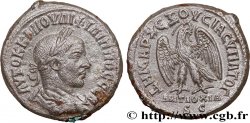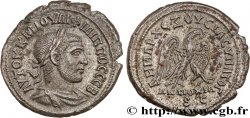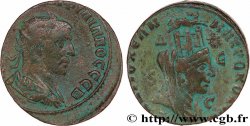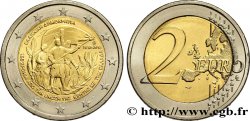E-auction 287-207004 - bpv_154318 - PHILIPPUS Tétradrachme syro-phénicien
Чтобы принять участие в торгах, вы должны войти в систему и стать подтвержденным участником аукциона. Войдите, чтобы сделать ставку. Ваш аккаунт будет подтвержден в течение 48 часов. Не ждите до закрытия торгов, чтобы зарегистрироваться.Сделав ставку на данный товар, вы вступаете в юридическое соглашение на покупку выбранного товара и нажатием кнопки «Сделать ставку» подтверждаете принятие вами условий интернет-аукционов cgb.fr.
Ставка может бить сделана только в полном эквиваленте евро. Торги закроются согласно времени, указанному в описании товара, все ставки, сделанные после закрытия торгов, учитываться не будут. Не следует откладывать предложение вашей ставки до последнего момента, так как система может не успеть обработать вашу заявку, и ваша ставка не будет принята. Более детальную информацию вы найдёте здесь: FAQ по интернет-аукционам.
БЕСПЛАТНО.
БЕСПЛАТНО.
| Оценить : | 220 € |
| Цена : | 101 € |
| Максимальная предлагаемая цена : | 101 € |
| Конец торгов : | 15 October 2018 15:01:30 |
| Участников : | 5 Участников |
Тип Tétradrachme syro-phénicien
Дата: 249
Монетный двор / Город: Antioche, Syrie, Séleucie et Piérie
Металл: billon
Диаметр: 28,00 mm
Ориентация осей монеты: 7 h.
Вес: 11,25 g.
Редкость: R2
Комментарии о состоянии
Plat de frappe sur la légende de droit, surface légèrement piquée
Ссылки в каталоге: :
Происхождение:
Cet exemplaire est le 0480_010 de la base TSP, ilprovient de la trouvaille dite de Doyen n° 61 dans le Numismatic Circular 1991 page 28
Лицевая сторона
Аверс: описание: Buste lauré, drapé et cuirassé de Philippe Ier à droite, vu de trois quarts en arrière (A*2), un globule sous le buste .
Аверс: легенда: AUTOK K M IOUL FILIPPOS SEB, (Autokratoros Kaisaros Markos Ioulios Filippos Sebastos)
Аверс: перевод: (L’empereur césar Marc Jules Philippe auguste).
Обратная сторона
Реверс: легенда: ANTIOXIA / S|C À L’EXERGUE.
Реверс: Описание: Aigle debout à gauche, les ailes largement déployées, tête à gauche et queue à droite, tenant une couronne feuillée dans son bec.
Реверс: легенда: DHMARC - EX OUSIAS UPATOD
Реверс: перевод: (Revêtu de la puissance tribunitienne / Consul pour la quatrième fois / avec l’accord du Sénat d’Antioche).
Комментарий
Ces frappes à marques d’officines sont la fin des émissions pour Philippe père et fils, simplement parce que cette même méthode se poursuivra sous le règne de son successeur, Trajan Dèce, alors qu’elle n’existe pas avant le quatrième consulat de Philippe.
Le marquage des officines se fait par points sous le buste, de un à quatre, mais il est possible, au style, de penser que ces émissions comportent aussi une officine sans point. Cette question se réglera, comme tant d’autres, par une reconstitution des chaînes de coins qui montrera, ou non, une série particulière, sans point, du même style de gravure des bustes que les frappes avec points.
Le classement des bustes avec deux points sous la cuirasse, qui se trouvent tant pour le père que pour le fils, dans cette série à officines indiquées, est pratiquement certain. Les arguments en faveur sont la faiblesse des émissions de Philippe père, pour la deuxième officine, avec le buste standard ; on peut donc penser que la production de cette officine a été répartie entre les deux types de bustes alors que celles des autres se concentraient sur des bustes standards, laurés, drapés et cuirassés à droite.
Pour le fils, les émissions avec deux points sous la cuirasse viennent peut-être compléter les émissions de cette officine à buste standard car, là, ce sont les frappes avec aigle à droite qui sont inconnues et n’existent peut-être pas.
Ces émissions sont fort rares et précèdent certainement de très peu la chute des Philippe. On ne peut pas déterminer actuellement le motif de cette réorganisation, peut-être à réfléchir en comparaison avec les frappes d’antoniniens.
Curieusement, elles sont peu présentes en musées, ou d’acquisitions récentes. Aucun exemplaire n’est référencé dans le BMC et il semble que sans les trouvailles de Doura, l’émission serait restée ignorée.
Dès que Philippe II est proclamé auguste, il utilise toujours les titres de son père au revers mais encore adopte sa titulature de droit. Les collectionneurs débutants ont d’ailleurs des difficultés à distinguer le père du fils ; la règle est simple : le père a toujours une ride qui barre le front, le fils toujours un front lisse.
On note que les sigma sont gravés en C.
Dans la base TSP maintenue par Michel Prieur, onze exemplaires sont maintenant répertoriés pour ce type, dont trois en musées, deux à l’ANS et un à Paris, 1988-147, provenant de Fribourg 500.
These strikes with office marks are the end of the issues for Philip father and son, simply because this same method will continue under the reign of his successor, Trajan Decius, whereas it does not exist before the fourth consulate of Philip.
The marking of the pharmacies is done by points under the bust, from one to four, but it is possible, from the style, to think that these emissions also include a pharmacy without points. This question will be resolved, like so many others, by a reconstruction of the chains of dies which will show, or not, a particular series, without point, of the same style of engraving of the busts as the strikes with points.
The classification of the busts with two points under the armor, which are found for both the father and the son, in this series with indicated offices, is practically certain. The arguments in favor are the weakness of the issues of Philippe père, for the second workshop, with the standard bust; we can therefore think that the production of this workshop was divided between the two types of busts while those of the others concentrated on standard busts, laureates, draped and cuirassed on the right.
For the son, the issues with two points under the armor perhaps complement the issues of this office with a standard bust because, there, it is the strikes with an eagle on the right which are unknown and perhaps do not exist..
These issues are very rare and certainly precede the fall of the Philippes by a very short time.. The reason for this reorganization cannot be determined at present, perhaps in comparison with the Antoninian strikes..
Curiously, they are rarely found in museums, or are recent acquisitions.. No example is referenced in the BMC and it seems that without Doura's finds, the broadcast would have remained unknown..
As soon as Philip II was proclaimed Augustus, he still used his father's titles on the reverse but also adopted his title by right.. Beginner collectors have difficulty distinguishing the father from the son; the rule is simple: the father always has a wrinkle across his forehead, the son always has a smooth forehead..
Note that the sigmas are engraved in C.
In the TSP database maintained by Michel Prieur, eleven examples are now listed for this type, including three in museums, two at the ANS and one in Paris, 1988-147, coming from Fribourg 500
Le marquage des officines se fait par points sous le buste, de un à quatre, mais il est possible, au style, de penser que ces émissions comportent aussi une officine sans point. Cette question se réglera, comme tant d’autres, par une reconstitution des chaînes de coins qui montrera, ou non, une série particulière, sans point, du même style de gravure des bustes que les frappes avec points.
Le classement des bustes avec deux points sous la cuirasse, qui se trouvent tant pour le père que pour le fils, dans cette série à officines indiquées, est pratiquement certain. Les arguments en faveur sont la faiblesse des émissions de Philippe père, pour la deuxième officine, avec le buste standard ; on peut donc penser que la production de cette officine a été répartie entre les deux types de bustes alors que celles des autres se concentraient sur des bustes standards, laurés, drapés et cuirassés à droite.
Pour le fils, les émissions avec deux points sous la cuirasse viennent peut-être compléter les émissions de cette officine à buste standard car, là, ce sont les frappes avec aigle à droite qui sont inconnues et n’existent peut-être pas.
Ces émissions sont fort rares et précèdent certainement de très peu la chute des Philippe. On ne peut pas déterminer actuellement le motif de cette réorganisation, peut-être à réfléchir en comparaison avec les frappes d’antoniniens.
Curieusement, elles sont peu présentes en musées, ou d’acquisitions récentes. Aucun exemplaire n’est référencé dans le BMC et il semble que sans les trouvailles de Doura, l’émission serait restée ignorée.
Dès que Philippe II est proclamé auguste, il utilise toujours les titres de son père au revers mais encore adopte sa titulature de droit. Les collectionneurs débutants ont d’ailleurs des difficultés à distinguer le père du fils ; la règle est simple : le père a toujours une ride qui barre le front, le fils toujours un front lisse.
On note que les sigma sont gravés en C.
Dans la base TSP maintenue par Michel Prieur, onze exemplaires sont maintenant répertoriés pour ce type, dont trois en musées, deux à l’ANS et un à Paris, 1988-147, provenant de Fribourg 500.
These strikes with office marks are the end of the issues for Philip father and son, simply because this same method will continue under the reign of his successor, Trajan Decius, whereas it does not exist before the fourth consulate of Philip.
The marking of the pharmacies is done by points under the bust, from one to four, but it is possible, from the style, to think that these emissions also include a pharmacy without points. This question will be resolved, like so many others, by a reconstruction of the chains of dies which will show, or not, a particular series, without point, of the same style of engraving of the busts as the strikes with points.
The classification of the busts with two points under the armor, which are found for both the father and the son, in this series with indicated offices, is practically certain. The arguments in favor are the weakness of the issues of Philippe père, for the second workshop, with the standard bust; we can therefore think that the production of this workshop was divided between the two types of busts while those of the others concentrated on standard busts, laureates, draped and cuirassed on the right.
For the son, the issues with two points under the armor perhaps complement the issues of this office with a standard bust because, there, it is the strikes with an eagle on the right which are unknown and perhaps do not exist..
These issues are very rare and certainly precede the fall of the Philippes by a very short time.. The reason for this reorganization cannot be determined at present, perhaps in comparison with the Antoninian strikes..
Curiously, they are rarely found in museums, or are recent acquisitions.. No example is referenced in the BMC and it seems that without Doura's finds, the broadcast would have remained unknown..
As soon as Philip II was proclaimed Augustus, he still used his father's titles on the reverse but also adopted his title by right.. Beginner collectors have difficulty distinguishing the father from the son; the rule is simple: the father always has a wrinkle across his forehead, the son always has a smooth forehead..
Note that the sigmas are engraved in C.
In the TSP database maintained by Michel Prieur, eleven examples are now listed for this type, including three in museums, two at the ANS and one in Paris, 1988-147, coming from Fribourg 500







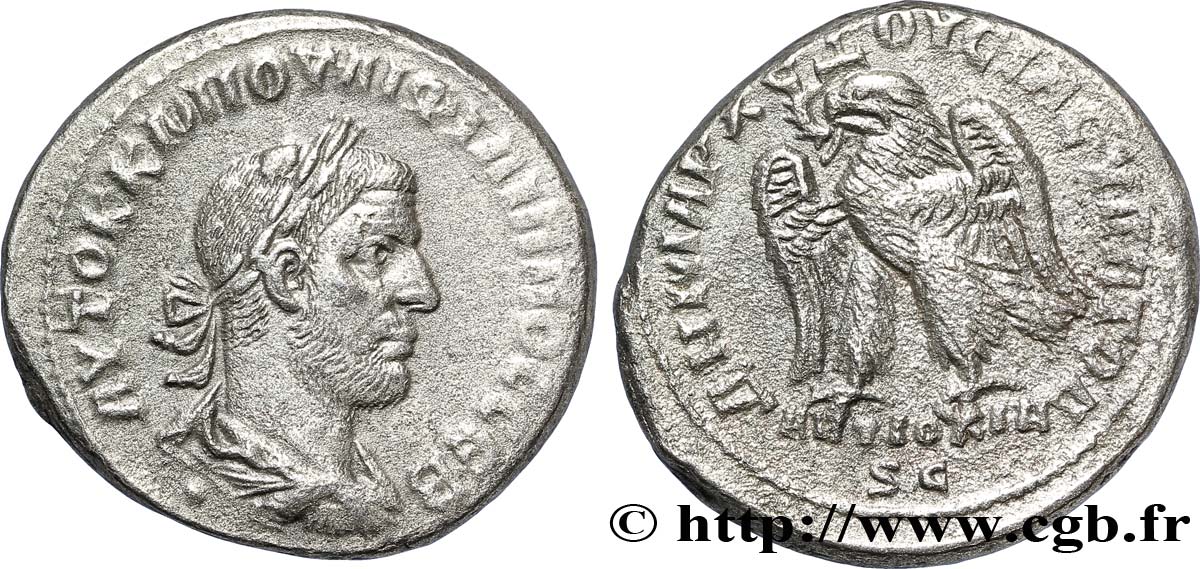
 Cообщить об ошибке
Cообщить об ошибке Распечатать страницу
Распечатать страницу Отправить мой выбор
Отправить мой выбор Задать вопрос
Задать вопрос Consign / sell
Consign / sell
 Информация
Информация
